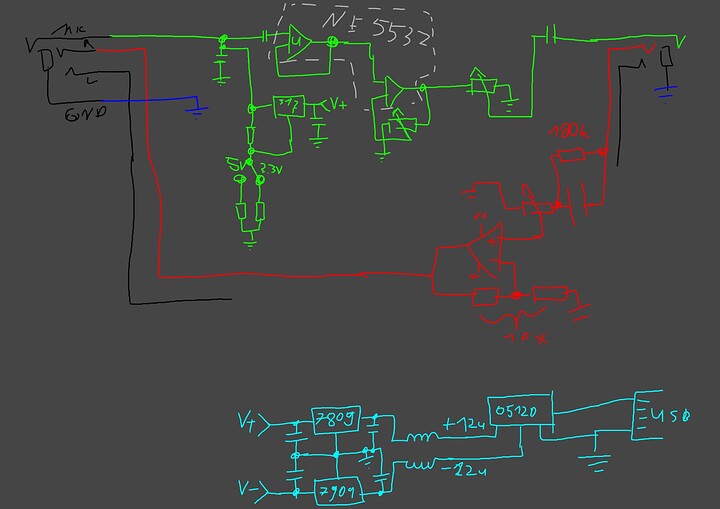TRRS-Ampy
A friend of mine is using a TRRS-connected headset. While the quality is good, the volume is just too low.
Feature List:
brackets mark optional features
- USB powered (= 2.5W power draw limit)
- Mic Preamp
- variable gain
- selectable bias voltage (3.3 and 5V)
- (variable feedback)
- (HP-Amp)
- (Variable Gain)
- Nice enclosure!!! no cardboard engineering!
First idea sketch:
Darkmode friendly, but not for the faint of heart, and mouse drawn!
Easy first:
I/O: TRRS jacks for easy connecting, I will likely put TRS jacks in parallel for pure Headphone amp use. USB Mico/Mini/B and likely a barrel jack (5.5x2.1mm) for power in. End of the easy part.
Boosting low-level signals is pretty easy, thanks to the NE5532 Op-Amp. I am going to use half of it as a unity-gain buffer and then boost that using the other half of it. I have seen this set up in cheaper commercial Mic-Preamps, so should work for me too.
To make this not look janky, I will probably stuff this into a Fischer or Hammond enclosure.
The harder parts:
-
Elektret mics need some bias voltage. Ask 10 people on how much they need and get 11 answers. I personally had good luck with 3.3V and 5V in the past, see here for a successful implementation.
-
Since I have bias-voltage and a DC-coupled amp section, I need a capacitor (or transformer) to only get the AC (= audio). Again, the internet has n+1 opinions on the type and value of this coupling cap…
-
Power availability. Since I want this to run of USB 2.0, I am looking at 5V @ 500mA (= 2.5W). Via barrel jack, I could go higher, however nobody wants another power brick.
In case someone here knows what I need to do to pull 900mA the USB 3.1 Gen 1 spec allows, let me know!
The Impossible Guesswork and Prayers part:
-
Power. For the Op-Amps to do their work correctly, they need clean power and higher-than-USB 2.0 voltages. My previous experiment with a Traco TBA2 0512 revealed, noise and ripple straight from hell (could add Wifi to make it worse
 )
)
So I need decent filtering after it, then linear regulators to get the ripple and voltage droop smoothed out. The light blue part in the scribble above has multiple caps and a pair of inductors in it, not sure if that is enough though! -
Audio, for the headphones. I intend to make this easy and just use a single NJM 4580D Op-Amp. These served me well for experiments and projects in the past. The main problem is: I have no idea what the notebook or USB-Dongle throws out. May be ground referenced, may be floating, no clue. How do I make sure this does not go wrong?
-
Ground and shielding. This will be a nightmare. Since USB is noisy, and potentially running of a laptop (floating) and I need DC-DC boost conversion, I will have multiple ground levels to deal with. Does anyone know what to do here? Just high-impedance DC-path? Or Low-Pass filters connecting all ground levels?
